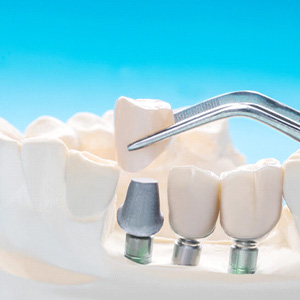
Missing teeth do more harm than simply creating gaps in your smile. When you lose one or more teeth, the bone that supports those teeth deteriorates. This increases the risk of your teeth shifting out of place and further tooth loss. At Radiance Dentistry in Irving, TX, we offer a few different options to replace missing teeth. Dr. Mounir Iskandar can explain the differences between traditional vs. implant-supported bridges, and discuss the benefits that dental implants offer.
Both types of bridges will fill the gaps in your smile to create a more aesthetically pleasing appearance. Filling the gaps will also improve your speech and ability to chew foods with comfort. There are some key differences, though. A consultation with Dr. Iskandar can help you determine which type of dental bridge is right for your particular needs.
TRADITIONAL DENTAL BRIDGES
A traditional dental bridge can replace two to three missing teeth in a row, sometimes more. The bridge consists of artificial teeth in the center, which are supported on either end by dental crowns. Those crowns are permanently affixed to the healthy teeth one either side of the gap of missing teeth.
There are advantages and disadvantages to a traditional dental bridge:
- Advantages: A traditional bridge does not require any surgery and almost all patients are good candidates. Traditional bridges are available in tooth-colored materials like porcelain, so patients can maintain a natural appearance. By filling in the gap of missing teeth, the surrounding teeth are kept in place, preventing shifts and misalignment. This option is the most affordable and can be completed in the course of two appointments.
- Disadvantages: Traditional bridges cannot prevent the deterioration of the jawbone that occurs after tooth loss. The dental crowns that support a traditional bridge require the alteration, and thus weakening, of the healthy tooth structure.
IMPLANT-SUPPORTED DENTAL BRIDGES
An implant-supported bridge is similar to a traditional bridge in that it consists of artificial teeth. Rather than attaching to the nearby healthy teeth, however, the bridge is affixed to dental implants. The implants are surgically placed in the jaw and after a healing period, the bridge is attached. As with traditional bridges, the implant-supported bridge offers both advantages and disadvantages:
- Advantages: The biggest advantage of an implant-supported bridge is that it prevents jawbone deterioration. It also preserves the healthy structure of the surrounding teeth, while preventing complications like misalignment and further tooth loss.
- Disadvantages: An implant-supported bridge does require surgery. This can be a lengthy process for many patients, as the healing period can take three to six months. The surgical procedure also makes this a more expensive option when compared with a traditional bridge.
SCHEDULE A CONSULTATION TODAY
If you want improve your oral health and have a beautiful smile once more, contact our office to schedule a consultation with Dr. Iskandar. He can evaluate your oral health and discuss your budget and goals to determine which option is right for you.
